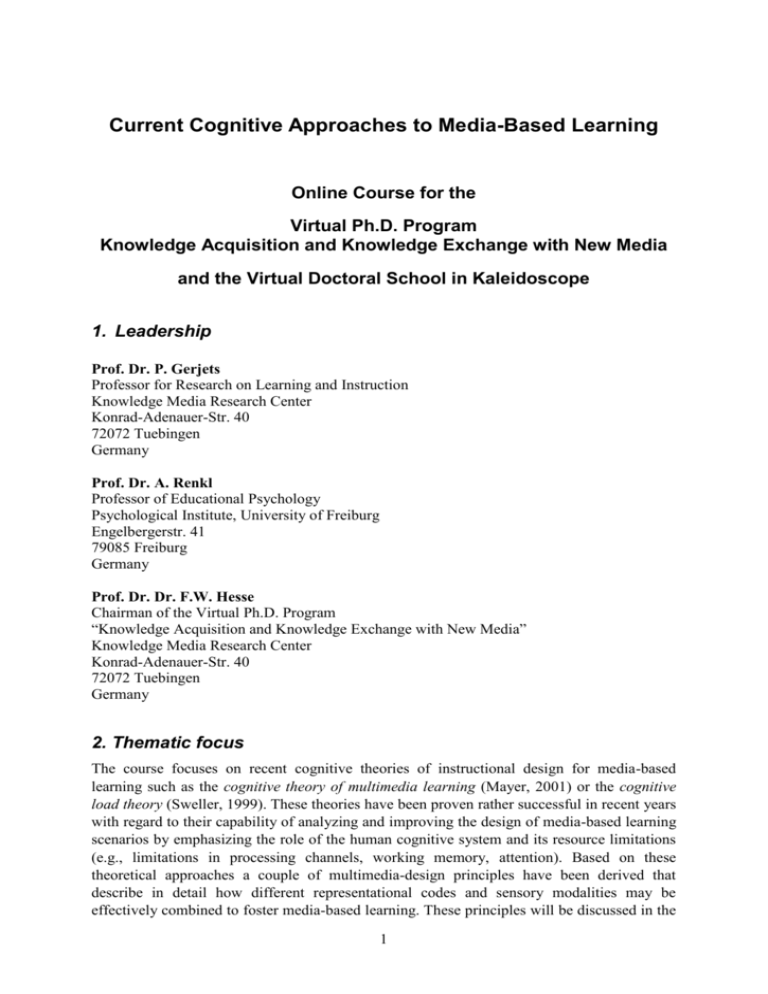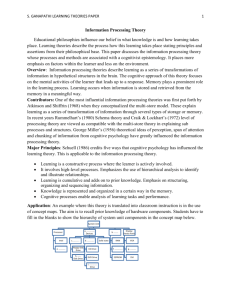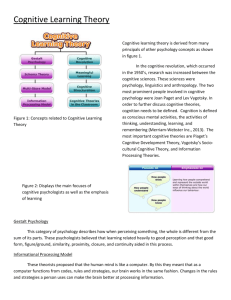Current Cognitive Approaches to Media
advertisement

Current Cognitive Approaches to Media-Based Learning Online Course for the Virtual Ph.D. Program Knowledge Acquisition and Knowledge Exchange with New Media and the Virtual Doctoral School in Kaleidoscope 1. Leadership Prof. Dr. P. Gerjets Professor for Research on Learning and Instruction Knowledge Media Research Center Konrad-Adenauer-Str. 40 72072 Tuebingen Germany Prof. Dr. A. Renkl Professor of Educational Psychology Psychological Institute, University of Freiburg Engelbergerstr. 41 79085 Freiburg Germany Prof. Dr. Dr. F.W. Hesse Chairman of the Virtual Ph.D. Program “Knowledge Acquisition and Knowledge Exchange with New Media” Knowledge Media Research Center Konrad-Adenauer-Str. 40 72072 Tuebingen Germany 2. Thematic focus The course focuses on recent cognitive theories of instructional design for media-based learning such as the cognitive theory of multimedia learning (Mayer, 2001) or the cognitive load theory (Sweller, 1999). These theories have been proven rather successful in recent years with regard to their capability of analyzing and improving the design of media-based learning scenarios by emphasizing the role of the human cognitive system and its resource limitations (e.g., limitations in processing channels, working memory, attention). Based on these theoretical approaches a couple of multimedia-design principles have been derived that describe in detail how different representational codes and sensory modalities may be effectively combined to foster media-based learning. These principles will be discussed in the 1 course with regard to their theoretical background in cognitive psychology as well as with regard to their application to computer-supported learning scenarios (e.g., “illustrations in instructional design”, “learning with interactive-dynamic visualizations”, “animations and simulations”, or “hypermedia exploration”). The course is developed for Ph.D. students of (educational) psychology or related fields. Therefore, the target group should consist of both the German Ph.D. students of the Virtual Ph.D. Program “Knowledge Acquisition and Knowledge Exchange with New Media” and the Ph.D. students of the different collaborative institutes from other European countries. 3. Goals of the Course The goal of the course is to provide students with a deeper understanding of the cognitive theory of multimedia learning and of the cognitive load theory. In particular we will focus on a comparison of these two approaches, on the instructional principles that can be derived from them, their theoretical background in cognitive psychology, and on a couple of open methodological questions. In order to achieve this goal, the following questions will be the addressed in the course: 1. What are the main assumptions of both theories and how are these assumptions used to explain instructional-design principles? How can these assumptions be tested (e.g., distinctions between different types of cognitive load). 2. How do these theories address different types of limited cognitive resources (e.g., selective attention, working memory span, processing channels)? 3. Are these explanations logical sound, consistent, and in line with the state of the art in cognitive psychology? Are both theories in accordance with mainstream memory models, for instance, Baddeley (2003)? 4. Are there theoretical flaws in the two theories? Which modifications and augmentations would be necessary to smooth out these deficits? 5. Which research methods should be applied to improve the theories? What about measurement issues (e.g., measurement of different types of cognitive load)? 6. How can we combine the theories of Sweller and Mayer with other - more concrete theories or models in order to go beyond their current status as coarse heuristic frameworks? 7. Are there new developments in working-memory concepts that have implications for cognitive-load research? Examples may be: Number and types of functional memory structures, intraindividual and interindividual differences in working-memory capacity, role of working-memory resources for different types of cognitive processing (math, language, learning, problem solving, visualization etc.). We will probably not find final answers to these questions, however, the participants will surely arrive at the conclusion: "I am still confused - but on a much higher level!" 2 4. References Thematic block I: Multimedia design principles: Theory and evidence In this part of the course (December 1st 2004 – February 1st 2005) we will review seven of the main multimedia design principles which build the core of the cognitive theory of multimedia learning (Mayer, 2001) and of the cognitive load theory (Sweller, 1999). The principles covered will be: Multimedia principle Contiguity/split-attention principle Redundancy principle Modality principle Signaling principle (flashing, signaling, dyna-linking) Interactivity principle for dynamic representations (segmenting) Adaptivity principle (individualizing, expertise reversal effect). The main focus will be to compare the two theories with regard to the explanations they offer for these principles. Students will be required to work in small groups whereby each group will discuss one of the principles from both theoretical perspectives. Each group is expected to review the empirical literature with regard to one principle in greater depth. Moreover, each group will be asked to write a paper on „their“ principle (i.e., theoretical explanations, empirical evidence, possible empirical as well as theoretical flaws). This paper will be commented by another group and by the course instructors. This part of the course will end by having a chat conference to discuss the seven principles. Basic references: Mayer, R. E. (2001). Multimedia learning. Cambridge: Cambridge University Press. Mayer, R. E. & Moreno, R. (2003). Nine ways to reduce cognitive load. Educational Psychologist, 38, 43-52. Sweller, J. (1999). Instructional design in technical areas. Camberwell: ACER. Sweller, J., van Merriënboer, J. J. G. & Paas, F. G. W. C. (1998). Cognitive architecture and instructional design. Educational Psychology Review, 10, 251-296. Kalyuga, S., Ayres, P., Chandler, P., & Sweller, J. (2003). The expertise reversal effect. Educational Psychologist, 38, 23-31. Thematic block II: Working-memory models, modality-specific processing channels, and critical points of cognitive load approaches In this part of the course (February 2nd 2005 – April 21st 2005) we will first have a look at theories of working memory (i.e., Baddeley, 2002, 2003) and modality-specific processing channels (i.e., Paivio, 1986, 1990; Schnotz, Bannert & Seufert, 2002) in cognitive psychology that are often referred to in Mayer’s or Sweller’s theory. We will inspect whether these theories and models can really be used to explain the principles in question. Second, we will review other working-memory models and models of learning from multiple representations that are currently being discussed in cognitive psychology to see whether they are in line with 3 the assumptions made in multimedia design theories and whether they can add anything to the discussion in this area (cf., Myake & Shaw, 1999). A third issues concerns the question of how cognitive load should be measured and other critical points of cognitive load approaches (cf., Brünken, Plass & Leutner, 2003, 2004; Paas, Tuovinen, Tabbers & Van Gerven, 2003). The students will be asked to write a paper that relates this literature to „their“ principle. Again, the paper will be commented by another group and by the course instructors. This part of the course will end by having a final workshop. Basic references: Baddeley, A. (2002). Is working memory still working? European Psychologist, 7, 85-97. Baddeley, A. (2003). Working memory: Looking back and looking forward. Nature Reviews Neuroscience, 4, 829-839. Brünken, R., Plass, J. L. & Leutner, D. (2003). Direct measurement of cognitive load in multimedia learning. Educational Psychologist, 38, 53-61. Brünken, R., Plass, J.L., & Leutner, D. (2004) Assessment of cognitive load in multimedia learning with dual-task methodology: Auditory load and modality effects. Instructional Science, 32, 115-132. Myake, A. & Shaw, P. (1999). Models of working memory. Cambridge: Cambridge University Press. Paas, F., Tuovinen, J., Tabbers, H. & Van Gerven, P.W.M. (2003). Cognitive load measurement as a means to advance cognitive load theory. Educational Psychologist, 38, 63-72. Paivio, A. (1986, 1990). Mental representations. New York: Oxford University Press. Schnotz, W., Bannert, M. & Seufert, T. (2002). Towards an integrative view of text and picture comprehension: Visualization effects on the construction of mental models. In J. Otero, A. Graesser & J. A. Leon (eds.), The Psychology of Science Text Comprehension (pp.385-416). Mahwah, NJ: Erlbaum. 5. Final Workshop 20/21. April 2005 Part 1: Presentations of participants Part 2: Invited Speakers: Prof. Dr. Roland Brünken, Georg August University of Göttingen: Topic: “Measuring cognitive load: concepts – problems – perspectives” PD Dr. Ralf Rummer, Saarland University: Topic: „Modality Effect(s) in Multimedia Learning and Verbal Short-Term Memory“ Prof. Dr. Wolfgang Schnotz, Koblenz-Landau University: Topic: „Working Memory and Learning: Misinterpretations of Cognitive Load Theory in Instructional Settings.“ 4






